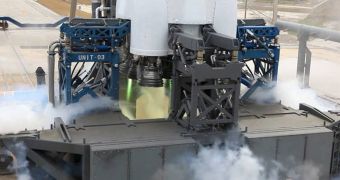Officials at the Hawthorne, California-based Space Exploration Technologies Inc. (SpaceX) announce that they have canceled a planned, 3.5-second test burn of their new medium-lift rocket, the Falcon 9. The rocket, which sits atop a Florida launch pad, experienced a small, unspecified glitch, and engineers decided to abort for the day, in order to investigate. This is the first time an abort test was conducted at the current launch facility, so nobody wanted to take any chances. The rocket is complete, and has thus far successfully undergone all tests and maneuvers required of it, Space reports.
“Today SpaceX performed our first Static Fire for the Falcon 9 launch vehicle. We counted down to […] T-2 seconds and aborted on Spin Start. Given that this was our first abort event on this pad, we decided to scrub for the day to get a good look at the rocket before trying again. Everything looks great at first glance. We'll look to do the next static fire attempt in three or four days,” a statement on the company's website says. The abort sequence was initiated just as the 9 Merlin engines that powered up the first stage of the Falcon 9 were about to roar to life for a period of nearly four seconds.
“As part of the abort, we close the pre-valves to isolate the engines from the propellant tank and purge the residual propellants. The brief flames seen on the video are burn off of [liquid oxygen] and kerosene on the pad. The engines did not ignite and there was no engine fire. We detanked and safed the vehicle and launch pad. Preliminary review shows all other systems required to reach full ignition were within specification. All other pad systems worked nominally,” company officials write in the same statement. The problem was identified in the rocket's spin start system, but representatives at the company have not made public the nature of the error.
Under the contract the company signed with the American space agency, NASA, it needs to conduct its first demo flight in the first half of 2010, with another one scheduled for another launch date between May and November. By next year, the Falcon 9 should theoretically be able to deliver supplies to the International Space Station (ISS). The cargo will be placed in the Dragon space capsule, which will then become a part of the international fleet serving the outpost. The fleet also includes the Russian Progress and Soyuz capsules, the European Automated Transfer Vehicle (ATV), and the Japanese H-II Transfer Vehicle (HTV).

 14 DAY TRIAL //
14 DAY TRIAL //